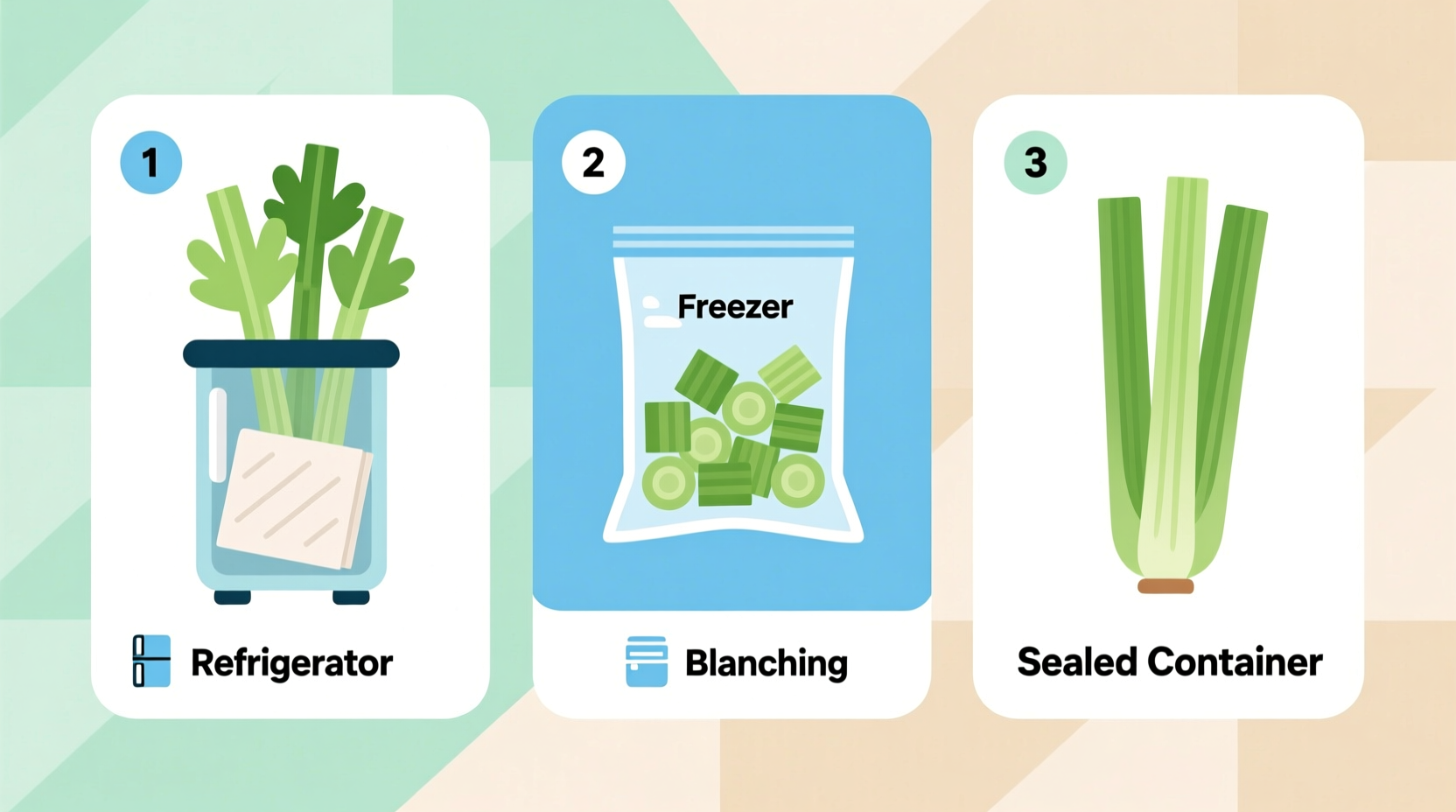Store celery upright in a container with 1-2 inches of water, covered with a plastic bag in the refrigerator for 2-4 weeks. For longer preservation, blanch and freeze for up to 12 months or dehydrate for 6-12 months of shelf life.
Nothing's more frustrating than watching crisp celery turn limp and rubbery within days of bringing it home. As a professional chef who's worked with produce for over 15 years, I've tested every celery preservation method available. The good news? With the right technique, you can extend celery's shelf life from mere days to several months while maintaining its crunch and flavor.
Why Celery Spoils So Quickly
Celery's high water content (95%) and hollow stalk structure make it particularly vulnerable to moisture loss. According to the USDA's postharvest handling guidelines, celery loses quality rapidly when exposed to air due to its high respiration rate. The key to preservation lies in maintaining optimal moisture levels while preventing bacterial growth.
Immediate Preservation: Keeping Celery Fresh for 1-3 Days
When you'll use celery quickly, these methods provide the simplest solutions:
Water Container Method
Cut about ½ inch off the base and place stalks upright in a container with 1-2 inches of water. Cover loosely with a plastic bag and refrigerate. This method mimics how celery grows, allowing it to continue absorbing moisture. University of California's Postharvest Technology Center confirms this technique maintains crispness by replenishing lost water through the cut base.
Aluminum Foil Wrap
Wrap the entire bunch tightly in aluminum foil, which allows ethylene gas (which accelerates spoilage) to escape while retaining moisture. This method works well for pre-cut celery sticks too. Research from the UC Davis Department of Plant Sciences shows aluminum foil creates the ideal microenvironment for celery storage.
| Preservation Method | Shelf Life | Best For | Crispness Retention |
|---|---|---|---|
| Water Container | 2-4 weeks | Whole stalks, maximum crispness | ★★★★★ |
| Aluminum Foil | 3-4 weeks | Whole bunches, pre-cut pieces | ★★★★☆ |
| Plastic Bag | 1-2 weeks | Short-term storage | ★★★☆☆ |
| Freezing (blanched) | 10-12 months | Cooking applications | ★★☆☆☆ |
| Dehydrating | 6-12 months | Seasonings, soups | N/A |
Medium-Term Storage: 2-4 Weeks of Freshness
For those who want celery ready for salads and snacks throughout the month, these methods deliver optimal results:
Optimal Refrigeration Technique
Combine the water container method with humidity control. After placing celery upright in water, cover with a perforated plastic bag (3-4 small holes) to maintain 95-100% relative humidity. The National Center for Home Food Preservation recommends this approach as it balances moisture retention with adequate air circulation to prevent mold.
Container Method with Damp Paper Towel
Place celery in an airtight container lined with a slightly damp paper towel. Replace the towel if it becomes too wet. This method works particularly well for pre-cut celery sticks. The damp towel provides consistent moisture without submerging the celery, which can lead to sogginess.
Long-Term Preservation: Months of Celery Availability
When you have a celery surplus or want to enjoy it year-round, these professional techniques deliver excellent results:
Freezing for Maximum Shelf Life
For cooked applications like soups and stews, freezing preserves flavor effectively:
- Wash and cut celery into desired sizes
- Blanch in boiling water for 3 minutes
- Immediately plunge into ice water for 3 minutes
- Dry thoroughly on clean towels
- Store in airtight freezer bags with air removed
The USDA Complete Guide to Home Food Preservation confirms blanching destroys enzymes that cause deterioration during frozen storage. Properly frozen celery maintains quality for 10-12 months.

Dehydrating for Concentrated Flavor
Dehydrated celery makes excellent seasoning and soup base:
- Slice celery thinly (1/8 inch)
- Arrange on dehydrator trays
- Dehydrate at 125°F (52°C) for 8-12 hours
- Store in airtight containers with oxygen absorbers
Dehydrated celery retains its flavor compounds for 6-12 months when stored properly. You can also grind it into celery powder for instant seasoning.
Critical Preservation Mistakes to Avoid
Certain common practices actually accelerate celery spoilage:
- Leaving celery in original plastic wrap - traps excess moisture leading to rot
- Storing near ethylene-producing fruits - apples, bananas, and tomatoes speed deterioration
- Washing before long-term storage - introduces excess moisture that promotes mold
- Storing at room temperature - celery loses quality 5-10 times faster outside refrigeration
Special Considerations for Celery Leaves
Don't discard those flavorful leaves! They preserve differently than stalks:
- Freeze leaves in ice cube trays with olive oil for instant flavor boosts
- Dehydrate leaves separately from stalks (they dry faster)
- Store fresh leaves in a jar with water like fresh herbs
How to Tell When Celery Has Gone Bad
While preserved celery lasts longer, it eventually deteriorates. Discard celery showing:
- Significant discoloration (yellowing or browning)
- Mushy texture or slimy coating
- Foul odor
- Visible mold growth
Slightly limp celery can often be revived by soaking in ice water for 30 minutes.
Preservation Timeline Comparison
Understanding how celery quality changes over time helps determine the best method for your needs:
- Days 1-7: All methods maintain excellent quality for raw consumption
- Weeks 2-3: Water container and foil methods maintain good texture for salads
- Weeks 4-6: Only frozen or dehydrated celery remains usable (for cooking)
- Months 3-6: Frozen celery maintains flavor for cooked dishes
- Months 6-12: Dehydrated celery powder remains potent for seasoning











 浙公网安备
33010002000092号
浙公网安备
33010002000092号 浙B2-20120091-4
浙B2-20120091-4